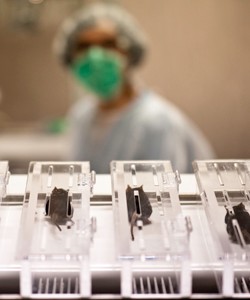This website uses cookies to ensure you get the best experience on our website. Learn more
Exercise testing consists of the determination of exercise capacity and endurance. Treadmills are generally used in mouse for forced exercise capacity to assess maximal endurance. A grid that delivers a mild electric shock is used to motivate the animal to run. Several variations of treadmill protocols can be performed with variation of speed, incline of the treadmill and duration of performance.
Exercise performance is a multifactorial process in which cardiovascular, neuromuscular and metabolic function all play key roles.
![]() Treadmill test: latency to exhaustion in 3 different strains
Treadmill test: latency to exhaustion in 3 different strains
![]() Treadmill test: distance covered in 3 different strains
Treadmill test: distance covered in 3 different strains
Treadmill device for mice (5 lines) (BIOSEB, Vitrolles, France)
8 mice per group are recommended for reliable data analysis
Thermoregulation can be evaluated through cold exposure test. Mice are placed in individual cages in a room with ambient temperature of 4°C for 4 to 6 hours. Rectal temperature is measured hourly by a rectal probe.
![]() Body temperature in different mice strain under cold exposure
Body temperature in different mice strain under cold exposure
8 mice per group are recommended for reliable data analysis
See energy expenditure by indirect calorimetry ; a food intake monitoring system is integrated to open flow respirometric device for the measurement of feeding/drinking behaviors. The cages allow food or drink restriction procedures as well as food or drink preference tests.
8 mice per group are recommended for reliable data analysis.
Mouse models are useful tools for studying obesity and diabetes. Mice fed with high-fat diets, such as lard (about 60% of calories from fat), display body-weight gain and eventually develop obesity as well as metabolic diseases. C57Bl/6 mice are the reference strain for such models. A battery of tests are proposed to explore energy metabolism, before and after 6 to 12 weeks of high fat diet, noted in the links below:
![]() Oral glucose tolerance test (OGTT)
Oral glucose tolerance test (OGTT)
8 mice per groups are recommended for reliable data analysis
The Apoe targeted mutation mice (Apoe -/-) are unable to produce apolipoprotein E which is essential for the transport and metabolism of lipids. These mice have a markedly altered plasma lipid profile compared to normal mice, and rapidly develop atherosclerotic lesions. A diet high in fat and cholesterol increases the incidence of atherosclerosis in these mice and this model is a useful model especially for pharmacological studies. Mice deficient in low density lipoprotein receptor (Ldlr) have an elevated serum cholesterol level and display very high levels when fed a high fat diet. This model is also commonly used for hyperlipidemia and atherosclerosis research.
Tests proposed:
8 mice per group are recommended for reliable data analysis
Dextran sulfate sodium (DSS) is a colon irritant and DSS-induced colitis is a widely used model for studying inflammatory bowel disease in rodents. A 2% DSS solution is given in the drinking water for 5 days; body weight, consistency of the feces and presence of blood in the feces are recorded daily. After 5 days, blood is collected for hematology, biochemistry and cytokine measurements and mice are sacrificed for histological examination of the colon.
![]() Scoring (body weight, feces consistency, blood in feces)
Scoring (body weight, feces consistency, blood in feces)
10 animals per group are recommended for reliable data analysis. Cohorts should be matched by gender.
Wound healing is a complex process requiring cell proliferation, extracellular matrix synthesis, inflammation, and contraction. The biological processes involved can reveal defects in immune response, nutrition, metabolism, or cell division. Wound healing analyses are performed on skin, which is a large and accessible organ, using full thickness excision method.
At least, 15 mutant mice versus 15 littermate control mice are required for relevant results.
Gross evaluation (healing rate and wound aspect evaluation)
At each time point:
Histological evaluations
